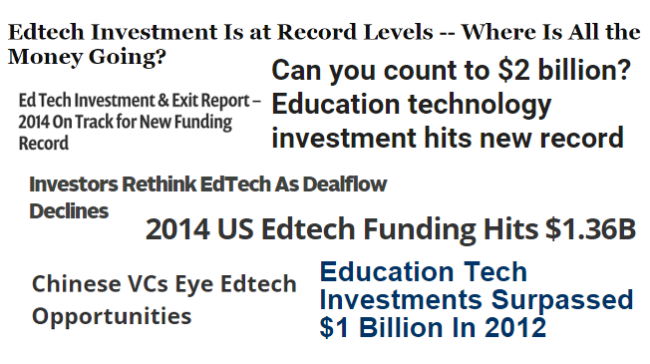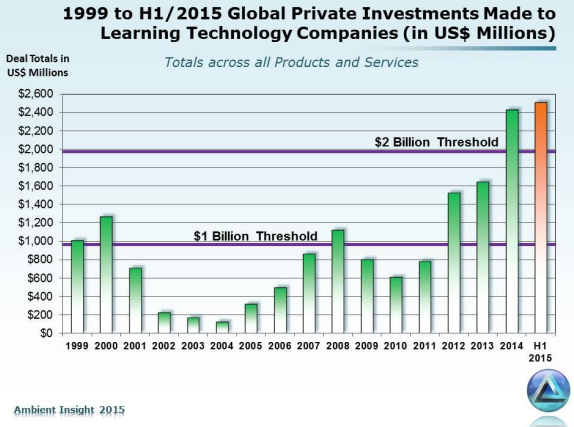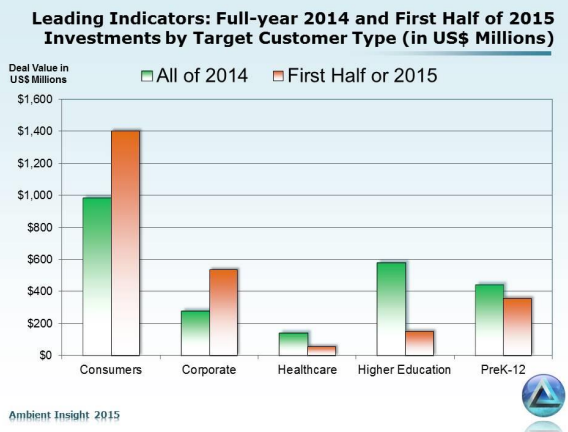You have /5 articles left.
Sign up for a free account or log in.

A collection of recent headlines about ed-tech deals.
Illustration Photo
With $2.51 billion invested in educational-technology companies during the first half of 2015, investors continue to defy fears that interest in the sector is waning. Yet analysts say the staggering figure distracts from what and who isn’t being funded.
Lynda.com in January set the pace for what has already become a record-setting year for investments in ed tech, announcing an investment of $186 million. The online learning platform, which was later acquired by LinkedIn for $1.5 billion, still holds the record for the largest funding amount so far this year, but investors have found plenty of other investment opportunities.
Between January and June, investors poured $2,512,803,700 into ed-tech companies, eclipsing the record high $2.42 billion invested in all of 2014 -- the first year investments broke the $2 billion barrier. Five years ago, during the turmoil of the global recession, investments only totaled about $600 million.
The data come from a white paper released by market research firm Ambient Insight, and includes investments in learning-technology companies in 118 countries serving both K-12 and higher education. Since the white paper only covers “instructional products directly involved in the learning process” -- excluding, for example, a $200 million funding round to a lending platform that also offers peer-to-peer student loans -- the total amount of investments directly or indirectly related to education is likely much larger.
Even with those qualifiers, Ambient Insight calls the results from the first six months of 2015 “astonishing” and “unprecedented.” Among ed-tech companies, meanwhile, there is a sense that investors are only beginning to take the market seriously.
“Relative to the size of education as a market, venture investment into the space is a small fraction of what it should be,” said John Baker, founder and CEO of learning management system provider D2L. “Given the contribution that education makes to overall society, GDP -- you name it -- we’re still well below what we should be seeing.”
Another roundup of deals, which looked at funding of venture capital-backed companies, found investments reaching $1.6 billion during the first two quarters of 2015, up from $944 million last year.
One reason for the growth seen this year: more companies are getting funded, and investors are cutting those companies larger checks. Last year, 13.4 percent of the 336 companies invested in received $10 million or more; so far this year, that share is up to 27 percent. Funding rounds larger than $100 million, previously a rarity, are growing more common. In the last 17 years, only 10 companies have cracked nine digits, but 2015 has already seen four such deals.
A second reason may be that the ed-tech market is still unsettled, and that investors are searching for eventual success stories. A previous Inside Higher Ed analysis, using data from research firm PitchBook, suggested many companies that received one round of venture capital funding received follow-on deals.
Investors are also finding new places to spend their money, for example in growing markets in Asia and South America. Twenty Chinese companies account for $798.6 million of the total dollars invested during the first half of 2015, already topping last year’s total of $634.4 million. That figure dwarfs the money invested in companies operating in India ($137 million) and Brazil ($97 million), but those countries are still on track for a manyfold increase in funding over last year. As a point of comparison, investments in Brazilian ed-tech companies previously peaked at $5.3 million in 2013.
Chinese companies hold five of the top 10 spots on the list of the largest funding amounts obtained this year; American, four; Brazilian, one.
Consumer Facing Up, Higher Ed Down
China is the “big growth driver” behind the 2015 numbers, said Max Woolf, a senior analyst with the research firm Eduventures. But the money invested in Chinese companies may be less impressive than it initially appears, he added. “If you think about the spending per learner in China, it’s really a drop in the bucket,” he said.
While the takeaway from this year’s market activity appears to be uninhibited growth, some segments of the market are trending down. Companies that primarily serve colleges and universities, for example, do not appear to be attracting investors’ interest. In fact, those companies received nearly $100 million less in funding during the first half of 2015 compared to the previous year -- $152.3 million versus $251.7 million.
Apart from learning management system provider Instructure’s $40 million funding round, “it looks like investors are staying away from [higher education] learning-tech companies,” Sam S. Adkins, chief researcher at Ambient Insight, said in an email.
Adkins, who wrote the white paper, pointed out that the higher education-facing sector of the ed-tech market pulled in a total of $579.6 million in 2014. “Things would have to pick up significantly for the [higher education] sector to accomplish that this year,” he said.
Consumer-facing companies, however, are receiving more funding than ever before. Adkins notes in the white paper that there was “virtually no investor interest in consumer-facing learning-technology companies between 2003 and 2009,” but since 2012, funding for those companies has grown from $626 million to $1.41 billion.
Adkins said he was not sure if the trend signals that investors’ behavior is changing. “There is huge interest in consumer-facing ed-tech companies (what we call retail education) but I don’t know if those investors used to fund [higher education-facing] companies,” he said.
Interest in consumer-facing companies is not restricted to education. Apple is the world’s most valuable company, and appears destined to become the first $1 trillion company in the U.S. Facebook’s market value this week reached $275 billion, passing General Electric.
But the education sector presents some specific quirks that may make investors more likely to favor consumer-facing companies, Woolf said. Colleges have long sales cycles, infrequently replacing administrative and other types of software. Federal regulations also make education a challenging market to navigate, he said.
To complicate matters, the line between higher education- and consumer-facing companies may be blurring. Even learning management system providers such as D2L, which traditionally have measured their success by how many colleges adopted their system, now offer products aimed at individual faculty members and students. Still, D2L's Baker said, the higher education-facing model is “critical.”
D2L, which was founded in 1999, waited until 2012 before it took in any outside investment -- $80 million. Two years later, it had raised another $85 million.
“I’ve been in the space long enough to have heard investors having no appetite whatsoever for ed tech,” Baker said. “I see that diminishing.”






